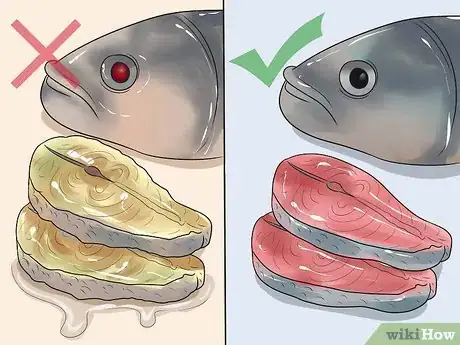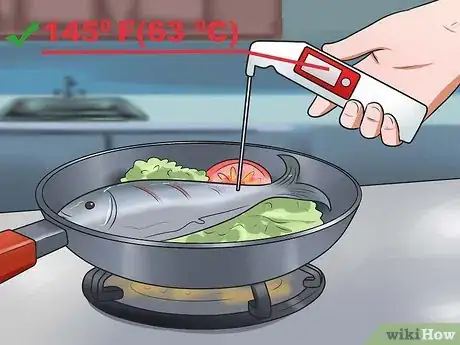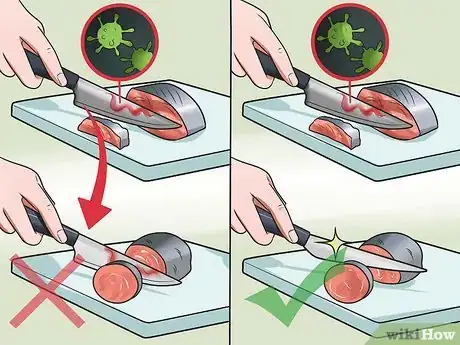This article was co-authored by Carrie Noriega, MD. Dr. Noriega is a Board Certified Obstetrician & Gynecologist and medical writer in Colorado. She specializes in women’s health, rheumatology, pulmonology, infectious disease, and gastroenterology. She received her MD from the Creighton School of Medicine in Omaha, Nebraska and completed her residency at the University of Missouri - Kansas City in 2005.
This article has been viewed 123,105 times.
Pregnant women are typically told to avoid fish due to its high mercury content and risk of food-borne illness. However, fish can be a source of nutrients important to your child’s prenatal development such as omega-3 fatty acids. High mercury intake has been linked to birth defects, but fish consumption in moderate amounts is important in pregnancy because key nutrients found only in fish help the baby's brain develop. With a few precautions, you can eat fish without ingesting an excess of mercury. The key to avoiding illness is proper storage and preparation of fish and moderation of consumption.[1]
Steps
Identifying Safe Fish
-
1Focus on fish sources with the lowest mercury levels. Virtually every type of seafood contains mercury, so look for those with the least mercury. Consume no more than 12 ounces of low-mercury fish per week. While moderate levels of mercury may not severely damage you and your child, you should only allow yourself 3 servings of 6 ounces of it each month. If you are eating at a restaurant, ask the waiter to find out how many ounces are in a fish entrée before consuming the entire filet.[2]
- Examples of high-mercury fish are swordfish, shark, mackerel, and tuna. It is advisable not to eat mercury-rich fish such as these during pregnancy.[3] . Look out for fish that taste especially metallic, a sign of high mercury levels.
- Medium-mercury fish include Chilean sea bass, grouper, cod, Mahi Mahi, monkfish, and snapper.
- Low-mercury fish are the safest for pregnant women. Some examples are anchovies, butterfish, catfish, flounder, haddock, herring, perch, Pollock, salmon, sardines, sole, tilapia, trout, whitefish, and whiting.
-
2Eat tuna rarely and in small quantities. Light tuna only has a little over a third of the mercury content of regular albacore tuna. That means it is harmless enough for you to eat, but only in moderation. A 5 ounce can of chunk light tuna can be consumed safely every 3 to 5 days, and Albacore canned tuna is safe to consume once every 9 to 12 days.[4]Advertisement
-
3Know where your fish is coming from. Mercury poisoning is not only a danger with naturally mercury-rich fish. Man-made environmental hazards such as power plants can contaminate surrounding waters and, as a result, nearby fish. Look for labels that tell you the fish came from a clean water source.
-
4Check for proper storage of fish before purchasing. Stored fish can contain chemicals or food-borne illnesses that can put you and your developing baby at risk of sickness. Though the fishing industry takes steps to properly ship, store, and clean their product, you should still be cautious. Look for fish packaged with a NOAA label, indicating it has been inspected by the National Oceanographic and Atmospheric Administration.
- Only buy fresh fish that is refrigerated or on fresh ice. Fish must be kept very cold to keep from spoiling, and it should be arranged to allow draining.
- Frozen fish should not be purchased if the bag has been opened or broken, or if ice crystals have formed on the fillets. Scales may be duller on frozen fish and the flesh may not be as firm once thawed, but it is typically safe to eat if the integrity of the packaging has been assured.
- Avoid refrigerated smoked fish. Examples of smoked fish are salmon, cod and tuna. Fish bought in the refrigerator section may contain listeria, a food-borne illness particularly threatening to pregnant women. Unless you are sure the refrigerated fish has been cooked thoroughly in a casserole or soup dish, buy canned fish instead.
-
5Double-check your purchase when you open it. You may not be able to identify all the warning signs of spoiled fish at the grocery store. When you get home, open the package and make sure everything looks and smells right. This will save you the hassle of having to go to a ‘plan B’ at dinnertime if the fish you purchased is inedible.
- Check to make sure the fish eyes are clear and slightly bulging. This indicates fresher fish.
- Do not purchase fish with discolored flesh. Green or yellow flesh may indicate that spoiling has begun. Dried or darkened edges also indicate that the fish has been sitting for too long and is no longer fresh.
- The flesh of fresh fish should be firm and should spring back into place after you touch it. The skin or scales on a fish filet should be shiny and free of slime. Gills should be bright red.
-
6Watch out for hidden sources of fish. Certain recipes may contain fish without advertising its presence. Ask about ingredients in egg salads or pasta dishes, ethnic foods like empanadas or sushi, garnishes like fish eggs, specialty spreads like smoked salmon cream cheese, imitation seafood products, and other foods sources. Most recipes for oil-based salad dressings such as Greek dressing also contain fish. When eating in a restaurant, ask the staff about the fish content of foods like these. [5]
Preparing Fish Correctly
-
1Prepare fish how you prepare other meats. You can prepare fish in much the same way that you prepare chicken or pork. There is not much of a difference in how you prepare fish compared with other types of meat.
-
2Thaw fish in the refrigerator. If fish is left unrefrigerated for too long, it can develop dangerous contaminants that can cause serious illness in pregnant women. If you have frozen fish, do not thaw it by leaving it on the counter. Instead, run the fish under cold water until it is thawed or leave it in the refrigerator overnight.
-
3Do not eat fish that has a strong odor. Stinky fish can make even healthy people sick, and is especially dangerous for your unborn child. Fish with strong fishy or sour smells, or an odor of ammonia should not be eaten. Though most fish generally emit a unique odor, only prepare fish if it smells mild and fresh.
-
4Cook all seafood thoroughly. Do not consume any fish product that has not been cooked through. Undercooked or raw fish may also transmit food-borne illness that may affect pregnant women more than others. The dangers of inappropriately prepared fish can be avoided with thorough cooking and safe preparation practices.
- Most seafood should be cooked to an internal temperature of 145 °F (63 °C). If you do not have a food thermometer, cook the fish until the flesh is opaque and flakes easily with a fork at multiple spots in the fillet.
-
5Do not cross-contaminate. If you are preparing fish that was previously raw, do not use any utensils, plates, or serving dishes to eat the fish after cooking. Use clean utensils and plates to serve prepared fish. Also, try to avoid mixing serving containers of fish to prevent the spread of fish-borne illness.
Expert Q&A
-
QuestionIs it okay to eat smoked dry fish during pregnancy or not?
 Carrie Noriega, MDDr. Noriega is a Board Certified Obstetrician & Gynecologist and medical writer in Colorado. She specializes in women’s health, rheumatology, pulmonology, infectious disease, and gastroenterology. She received her MD from the Creighton School of Medicine in Omaha, Nebraska and completed her residency at the University of Missouri - Kansas City in 2005.
Carrie Noriega, MDDr. Noriega is a Board Certified Obstetrician & Gynecologist and medical writer in Colorado. She specializes in women’s health, rheumatology, pulmonology, infectious disease, and gastroenterology. She received her MD from the Creighton School of Medicine in Omaha, Nebraska and completed her residency at the University of Missouri - Kansas City in 2005.
Board Certified Obstetrician & Gynecologist You should avoid eating all smoked fish during pregnancy. Smoked fish may contain listeria, a food-borne illness particularly threatening to pregnant women.
You should avoid eating all smoked fish during pregnancy. Smoked fish may contain listeria, a food-borne illness particularly threatening to pregnant women. -
QuestionDoes eating Tilapia from fresh water every day have any effects on pregnancy?
 Carrie Noriega, MDDr. Noriega is a Board Certified Obstetrician & Gynecologist and medical writer in Colorado. She specializes in women’s health, rheumatology, pulmonology, infectious disease, and gastroenterology. She received her MD from the Creighton School of Medicine in Omaha, Nebraska and completed her residency at the University of Missouri - Kansas City in 2005.
Carrie Noriega, MDDr. Noriega is a Board Certified Obstetrician & Gynecologist and medical writer in Colorado. She specializes in women’s health, rheumatology, pulmonology, infectious disease, and gastroenterology. She received her MD from the Creighton School of Medicine in Omaha, Nebraska and completed her residency at the University of Missouri - Kansas City in 2005.
Board Certified Obstetrician & Gynecologist Tilapia is a low mercury fish so it is safe to eat in pregnancy but you still need to limit your consumption to no more than 12 ounces per week.
Tilapia is a low mercury fish so it is safe to eat in pregnancy but you still need to limit your consumption to no more than 12 ounces per week.
Warnings
- If you are unsure as to the safety of a fish product or you are not aware of what type of fish a dish contains, refrain from eating it.⧼thumbs_response⧽
- If you feel ill within several days of eating any type of seafood, contact a medical professional immediately.⧼thumbs_response⧽
References
- ↑ http://www.mayoclinic.org/drugs-supplements/omega-3-fatty-acids-fish-oil-alpha-linolenic-acid/safety/hrb-20059372
- ↑ http://www.mayoclinic.org/healthy-lifestyle/pregnancy-week-by-week/in-depth/pregnancy-nutrition/art-20043844
- ↑ http://www.fda.gov/food/foodborneillnesscontaminants/metals/ucm115644.htm
- ↑ http://www.womenshealthmag.com/mom/should-pregnant-women-eat-canned-tuna
- ↑ http://americanpregnancy.org/pregnancy-health/mercury-levels-in-fish/
About This Article
If you want to eat fish during pregnancy, make sure you consume less than 12 ounces a week, since eating more than that can raise your mercury levels too high. Look for fish with the least mercury, such as anchovies, butterfish, haddock, herring, and salmon. It’s also important to check the label to make sure any fish you buy is from a clean water source, since other environments can contaminate your fish with unwanted chemicals. If you want to eat tuna while pregnant, limit yourself to 1 can every 3 to 5 days to keep your mercury levels under control. When cooking any fish, make sure it is cooked through and has an internal temperature of at least 125 degrees Fahrenheit to kill any bacteria that could make you sick. For more tips from our Medical co-author, including how to avoid accidentally eating fish in restaurants, read on!







































































